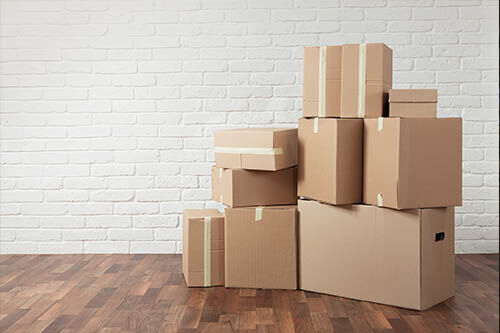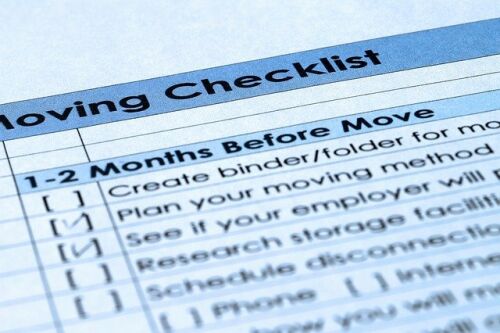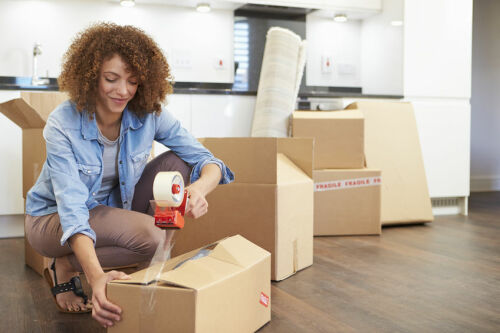Planning a move out of state can be daunting, whether you're moving for work, family, or other reasons. Our Complete Guide to Moving Out of State answers all your biggest questions about moving out of state, from creating to-do lists, planning, and budgeting for your move to downsizing, packing your belongings, and settling into your new home.
Jump to:
1. What room to pack first
Discover where to start packing when you're moving out of state.
2. What room to pack last
Find out which key space is worth packing up last.
3. Downsizing and decluttering
Get our advice for downsizing and decluttering so you can pack less and save more.
4. How to pack bedrooms, bathrooms, and living areas
Pack up commonly used spaces with these tips.

Packing to move out of state can seem like a daunting task. You have to hire movers, plan to ship boxes, set timelines, make checklists…it’s a lot of work. But the toughest part comes when you face the task of packing. You’ve got all the supplies—boxes, tape, bubble wrap, zip ties, markers—now where do you begin?
Take a deep breath, we’re here to help.
In this part of the Complete Guide to Moving Out of State, we’ll offer our advice for helping you pack your household to move. We’ll share tips on how to declutter and stay organized throughout the entire packing process, and we’ll also share some helpful checklists and other resources along the way, including:
- What room you should pack first
- What room you should pack last
- Downsizing and decluttering
- Packing bedrooms, bathrooms, and living areas
Let’s get started.
What Room Should You Pack First? The Kitchen
The kitchen is the best place to start packing for an out of state move because there are often lots of odds and ends tucked away in cupboards and drawers, including stuff you probably don’t use on a regular basis. It’s also a place where you can likely purge a lot of items—like duplicate utensils, unused gadgets and old appliances.
TSI TIP: Set aside a box of essential kitchen items you’ll need for the last few days in your old home and the first few days in your new home, such as cleaning supplies, dish towels, coffee machine, and a few dishes.
Packing up your kitchen also presents a great opportunity to clear out your pantry! It’s time to toss out those canned sardines that got lost far in the back oh so many years ago. You can also toss those old ice cream sprinkles and stale marshmallows.
Read our Kitchen Packing Guide for more tips and advice.
What Room Should You Pack Last? The Home Office
Whether you’re moving for work, working right up to the day of the move, or planning to get back to work the moment you arrive in your new state, we recommend packing your home office last.
Just about every home office is filled with important documents and equipment that you’ll want easy access to when you arrive at your new home, so pack this room as close to moving day as possible to minimize the interruption.
Even though you’re packing the home office last, there’s still an opportunity to declutter and lighten your load before moving day arrives. Books, for instance, are heavy to move, so now’s the time to donate what you no longer need. Consider unloading old dictionaries, kids’ books and that entire encyclopedia set. Ask yourself, “Will I ever actually use this book again?” If the answer is no, toss or donate it.
TSI TIP: Pack books by laying them flat or with their spine down toward the bottom of the box.
You can also make a pile of papers you no longer need—things like old tax receipts and bills dating back more than 6 years. To protect your privacy, we recommend shredding personal paperwork before throwing it out.
TSI TIP: Keep important documents, such as moving paperwork, your new lease, or insurance information, with you on moving day. Learn more about important moving paperwork to keep handy on moving day.
Next, toss out old cables and wires that no longer pair with your current equipment, like serial connection cables, unmatched power cords, and internet wires. Then safely dispose of all that old equipment you’ll never use, like landline phones and fax machines.
TSI TIP: Protect computers and electronics with bubble wrap and label the box with its content, the room it belongs to, “This side up” and “FRAGILE.”
Read our Home Office Packing Guide for more tips.
Downsizing and Decluttering
The costs of moving out of state can add up quickly, particularly if you’re hauling unnecessary junk from your basement, attic or garage. These are great places to start packing early for a long-distance move because you’ll likely find lots of stuff to toss away, such as:
- Paint cans
- Pesticides
- Pool chemicals
- Gas cans
- Rusty tools
- Batteries
- Old coats and boots
- Outdated furniture
- Broken appliances
The amount of stuff you keep or toss may depend on your moving method. If, for example, your new employer is covering your moving costs, you may have fewer budgetary constraints, which means you can keep more of your belongings. Or if you’re DIY-ing your move and you’re comfortable with the amount of labor, you may decide to keep more of your things as well.
On the flip side, if you're shipping items separately, it likely makes more sense to get rid of as much stuff as possible (excluding expensive or sentimental pieces), and simply ship boxes packed with essential household goods. In this case, you will likely want to declutter as much as possible before boxing up the truly important things you intend to take with you to your new home.
Here’s a short list of things you can just as easily (and inexpensively) replace on the other end:
- Used furniture (stuff you bought second hand at a garage sale or thrift store)
- “Hand-me-downs” (lamps, entertainment equipment, dishes, furniture)
- Couch cushions and window dressings
- Sheets, blankets, and towels (sometimes it’s just nice to start fresh)
- Trash and recycling bins
There are also some larger items you may no longer need, particularly if you’re downsizing from a house to an apartment or condo. You may want to sell or donate things like:
Lawnmowers, snowblowers, leaf blowers, and other landscaping tools
- Washer/dryer
- Extra fridges and freezers
- Bicycles
- Canoes or kayaks (and accessories)
- Sporting equipment and accessories (skis, skates, life jackets, helmets, etc.)
- Snowmobiles, motorcycles, or extra cars
- BBQs and propane tanks
- Patio furniture
Now that you’ve thoroughly decluttered, it’s time to begin packing up personal items.
How to Pack Bedrooms, Bathrooms, and Living Areas
Next up, it’s time to pack the bedrooms, bathroom, dining and living rooms. Always start by boxing up items you won’t need right away, such as:
- Artwork and seasonal decor items
- Off-season clothing
- Kids’ toys
- Extra toiletries (like soaps and lotions)
Read our Bedroom Packing Guide for more tips.
Take care to properly pack fragile items into strong new boxes using plenty of bubble wrap. Start with the items you don’t use every day, like:
- Fine china
- Champagne flutes
- Beer steins
- Extra wine glasses
- Statues and keepsakes
- Vases
- Punch bowls
- “Good” dishes
- Crystal
Be sure to clearly label your boxes not only so you know what’s inside when the time comes to unpack, but also so it’s obvious to movers that these items are fragile. For especially valuable or sentimental items, you may wish to invest in dish pack boxes that are specially designed for transporting these items safely.
You can also pack up all the things hiding in desk drawers, entertainment cabinets and storage areas like footstools and ottomans. Box up music, movies and video games, candles, knick knacks, and other items you can live without for a few weeks.
Wrapping Up
There’s no right or wrong way to pack for an out of state move. The key is to declutter and stay organized. Some people like to pack room by room, while others prefer to pack categorically.
Here are some helpful resources you can use to formulate a plan and stay organized for your out of state move:
- How to Move Out of State on a Budget
- How to Ship Boxes Out of State
- How to Ship Furniture Out of State








